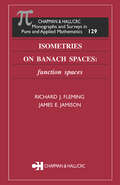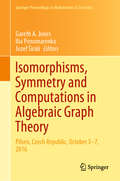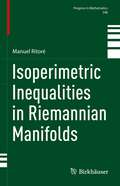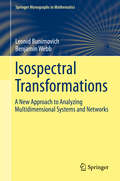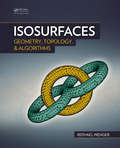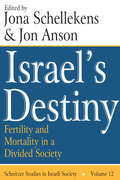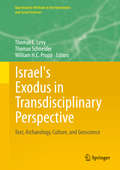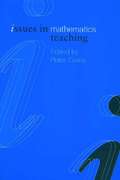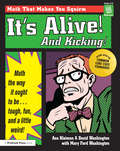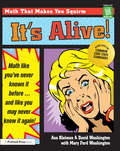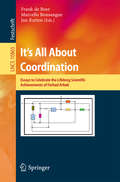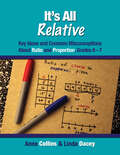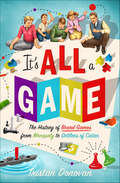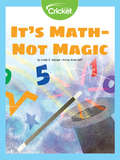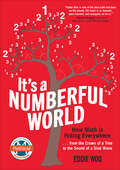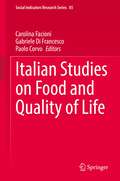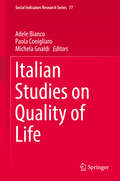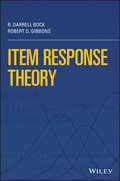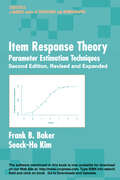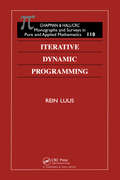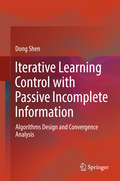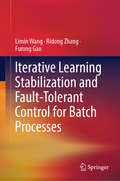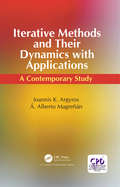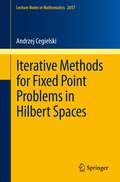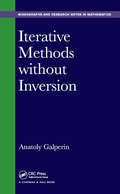- Table View
- List View
Isometries on Banach Spaces: function spaces (Monographs and Surveys in Pure and Applied Mathematics)
by Richard J. Fleming James E. JamisonFundamental to the study of any mathematical structure is an understanding of its symmetries. In the class of Banach spaces, this leads naturally to a study of isometries-the linear transformations that preserve distances. In his foundational treatise, Banach showed that every linear isometry on the space of continuous functions on a compact metric
Isomorphisms, Symmetry and Computations in Algebraic Graph Theory: Pilsen, Czech Republic, October 3–7, 2016 (Springer Proceedings in Mathematics & Statistics #305)
by Gareth A. Jones Jozef Širáň Ilia PonomarenkoThis book consists of a selection of peer-reviewed contributions to the Workshop on Algebraic Graph Theory that took place in Pilsen, Czech Republic in October 2016. Primarily intended for early career researchers, it presents eight self-contained articles on a selection of topics within algebraic combinatorics, ranging from association schemes to symmetries of graphs and isomorphism testing. Algebraic combinatorics is a compelling mathematical discipline based on the powerful interplay of algebraic and combinatorial methods. Algebraic interpretation of combinatorial structures (such as symmetry or regularity) has often led to enlightening discoveries and powerful results, while discrete and combinatorial structures have given rise to new algebraic structures that have found valuable applications. In addition to these original research contributions, the reader will find a survey linking numerous threads in algebraic combinatorics, and an extensive tutorial showcasing the universality of algebraic methods in the study of combinatorial structures.
Isoperimetric Inequalities in Riemannian Manifolds (Progress in Mathematics #348)
by Manuel RitoréThis work gives a coherent introduction to isoperimetric inequalities in Riemannian manifolds, featuring many of the results obtained during the last 25 years and discussing different techniques in the area. Written in a clear and appealing style, the book includes sufficient introductory material, making it also accessible to graduate students. It will be of interest to researchers working on geometric inequalities either from a geometric or analytic point of view, but also to those interested in applying the described techniques to their field.
Isospectral Transformations
by Leonid Bunimovich Benjamin WebbThis book presents a new approach to the analysis of networks, which emphasizes how one can compress a network while preserving all information relative to the network's spectrum. Besides these compression techniques, the authors introduce a number of other isospectral transformations and demonstrate how, together, these methods can be applied to gain new results in a number of areas. This includes the stability of time-delayed and non time-delayed dynamical networks, eigenvalue estimation, pseudospectra analysis and the estimation of survival probabilities in open dynamical systems. The theory of isospectral transformations, developed in this text, can be readily applied in any area that involves the analysis of multidimensional systems and is especially applicable to the analysis of network dynamics. This book will be of interest to Mathematicians, Physicists, Biologists, Engineers and to anyone who has an interest in the dynamics of networks.
Isosurfaces: Geometry, Topology, and Algorithms
by Rephael WengerEver since Lorensen and Cline published their paper on the Marching Cubes algorithm, isosurfaces have been a standard technique for the visualization of 3D volumetric data. Yet there is no book exclusively devoted to isosurfaces. Isosurfaces: Geometry, Topology, and Algorithms represents the first book to focus on basic algorithms for isosurface co
Israel's Destiny: Fertility and Mortality in a Divided Society
by AuthorFor over a hundred years, demography has been at the heart of the Zionist project, reflected in the goal of creating and maintaining a Jewish majority in Israel and in ensuring the physical continuation of the Jewish people. Demography continues to be an essential issue in the current struggle between Israel and Palestine. Yet in academic discourse, demography is treated as a minor, largely technical side-issue in the social sciences, with little theoretical consideration given to population processes as social processes. Israel's Destiny: Fertility and Mortality in a Divided Society brings together important recent work in this area. The contributions to Israel's Destiny focus on the influence of religion, religiosity, nationalism, and ethnicity on fertility and mortality in Israel.Israel's Destiny is divided into four sections: the first focuses on fertility, particularly Israel's apparently high birth rate when compared with other countries with a similar standard of living; the second looks at patterns of nuptiality and contraception and the way marriage patterns are shaping group boundaries; the third looks at mortality, particularly among men; and the fourth looks at social policy effects of the demographic process.The main focus is that differential reproduction of the population by national and ethnic group, as well as social class--through fertility and mortality--and the social structuring of the population--through marriage patterns--are critical elements in the creation and evolution of Israeli society. The editors' introduction places all these studies in a wider perspective of current demographic research. The volume provides a concise population history of the state of Israel to help the reader put the studies in their proper local and historical context.
Israel's Exodus in Transdisciplinary Perspective
by Thomas Schneider Thomas E. Levy William H.C. ProppThe Bible's grand narrative about Israel's Exodus from Egypt is central to Biblical religion, Jewish, Christian, and Muslim identity and the formation of the academic disciplines studying the ancient Near East. It has also been a pervasive theme in artistic and popular imagination Israel's Exodus in Transdisciplinary Perspective is a pioneering work surveying this tradition in unprecedented breadth, combining archaeological discovery, quantitative methodology and close literary reading. Archaeologists, Egyptologists, Biblical Scholars, Computer Scientists, Geoscientists and other experts contribute their diverse approaches in a novel, transdisciplinary consideration of ancient topography, Egyptian and Near Eastern parallels to the Exodus story, the historicity of the Exodus, the interface of the Exodus question with archaeological fieldwork on emergent Israel, the formation of biblical literature, and the cultural memory of the Exodus in ancient Israel and beyond. This edited volume contains research presented at the groundbreaking symposium "Out of Egypt: Israel's Exodus Between Text and Memory, History and Imagination" held in 2013 at the Qualcomm Institute of the University of California, San Diego. The combination of 44 contributions by an international group of scholars from diverse disciplines makes this the first such transdisciplinary study of ancient text and history. In the original conference and with this new volume, revolutionary media, such as a 3D immersive virtual reality environment, impart innovative, Exodus-based research to a wider audience. Out of archaeology, ancient texts, science and technology emerge an up-to-date picture of the Exodus for the 21st Century and a new standard for collaborative research.
Issues in Mathematics Teaching (Issues in Teaching Series)
by Peter GatesThis book presents the key debates that the mathematics teacher will need to understand, reflect on and engage in as part of their professional development. Issues in Mathematics Teaching is suitable for those at initial training level right through to practising mathematics teachers. Its accessible structure enables the reader to pursue the issues raised as each chapter includes suggestions for further reading and questions for reflection or debate.
It's Alive! And Kicking!: Math the Way It Ought to Be - Tough, Fun, and a Little Weird! (Grades 4-8) (Its Alive! Ser.)
by Asa Kleiman David Washington Mary Ford WashingtonThe authors, junior high students and best friends David and Asa, along with best-selling author Marya Washington Tyler, took the kind of gooey, slimy, disgusting science facts that students love and turned them into hilarious math problems. Your students will enjoy trying to determine what percent of the refrigerators in the U.S. contain moldy food. When's the last time you had your students figure the weight of cow manure produced in the U.S.?How many 8-ounce coffee mugs will an average person's sweat fill? What is the number of saliva droplets expelled in one class period?Your students won't mind math when they get to figure the cost of a meal at the Aftermath Restaurant, with foods like Deep Fried Lint, Pseudo-Chicken Parts, Wax Fruit Bowl, and Hot Sludge Sundae. Even the answer key is hilarious.These and other intriguing problems await your students in this book designed to teach children to translate statements and questions into mathematical equations. All the problems are based on known scientific facts. For even more exciting and strange math problems, see the original It's Alive!Grades 4-8
It's Alive!: Math Like You've Never Known It Before (Grades 4-8) (Its Alive! Ser.)
by Asa Kleiman David Washington Mary Ford WashingtonThe authors, junior high students and best friends David and Asa, along with best-selling author Marya Washington Tyler, took the kind of gooey, slimy, disgusting science facts that students love and turned them into hilarious math problems. Problems in It's Alive! include:When's the last time you had your students calculate their chances of being eaten by a crocodile?The percent of seats at Yankee Stadium that do not have gum stuck to them?The number of skin scales they lost in the last 20 minutes?The number of flushes it would take to overflow their city's wastewater treatment tank?Or how many gigabytes their brain can hold?These and other intriguing problems await your students in this book designed to teach children to translate statements and questions into mathematical equations. All the problems are based on known scientific facts.This is math. This is real. This is alive! Included is a comprehensive answer key, reproducible blackline masters, and hilarious illustrations. This is math the way it ought to be—tough, fun, and...a little weird. For even more exciting and strange math problems, see the follow-up It's Alive! And Kicking!Grades 4-8
It's All About Coordination: Essays Dedicated To Farhad Arbab On The Occasion Of His 65th Birthday (Theoretical Computer Science and General Issues #10865)
by Marcello Bonsangue Frank De Boer Jan RuttenThis Festschrift volume has been published to celebrate the lifelong scientific achievements of Farhad Arbab on the occasion of his retirement from the Centre of Mathematics and Computer Science (CWI).Over the years Farhad Arbab has sucessfully been engaged in scientific explorations in various directions: Software Composition, Service Oriented Computing, Component-based Software, Concurrency Theory, Coordination Models and Languages, Parallel and Distributed Computing, Visual Programming Environments, Constraints, Logic and Object-Oriented Programming.Farhad Arbab has shaped the field of Coordination Models and Languages. His insight that it is all about exeogeneous coordination gave rise to the striking elegance and beauty of Reo: an exogenous coordination model based on a formal calculus of channel composition. Reo has been extremely successful and is having a great impact in many of the areas mentioned above.The present volume collects a number of papers by several of Farhad’s close collaborators over the years.
It's All Relative: Key Ideas and Common Misconceptions about Ratio and Proportion, Grades 6-7
by Anne Collins Linda DaceyFor years, students have been taught to cross multiply when presented with proportion problems. Few understood what they were doing or why they were doing it. Rarely were students invited to think about various representations to determine the relationship between the two ratios being compared. The ideas and activities in this guide will help you provide students with the conceptual understanding of ratios and proportional thinking that is essential for solving real-world problems and achieving success in higher-level mathematics.It’s All Relative includes thirty modules, which are aligned to specific Common Core State Standards. Each module in this accessible, spiral-bound flipchart addresses specific mathematical practices and common misconceptions; features timely classroom examples; includes proven, ready-to-use activities; and provides ideas for adapting activities to meet the needs of individual learners. The authors particularly emphasize how to use visual models—tables, tape diagrams, graphs, and double number lines—to represent ratios and proportional thinking. These visual models, which may be new to many teachers, enhance students’ conceptual understanding and improve their ability to solve a wide range of proportional reasoning problems.
It's All a Game: The History of Board Games from Monopoly to Settlers of Catan
by Tristan Donovan“[A] timely book . . . a wonderfully entertaining trip around the board, through 4,000 years of game history.” —The Wall Street JournalBoard games have been with us even longer than the written word. But what is it about this pastime that continues to captivate us well into the age of smartphones and instant gratification?In It’s All a Game, Tristan Donovan, British journalist and author of Replay: The History of Video Games, opens the box on the incredible and often surprising history and psychology of board games. He traces the evolution of the game across cultures, time periods, and continents, from the paranoid Chicago toy genius behind classics like Operation and Mouse Trap, to the role of Monopoly in helping prisoners of war escape the Nazis, and even the scientific use of board games today to teach artificial intelligence how to reason and how to win. With these compelling stories and characters, Donovan ultimately reveals why board games—from chess to Monopoly to Risk and more—have captured hearts and minds all over the world for generations.“Splendid . . . A quick and breezy read, it doesn’t just tell the fascinating stories of the (often struggling) individuals who created our favorite games. It also manages to convey the entire sweep of board game history, from the earliest forms of checkers to modern-day surprise hits like Settlers of Catan.” —Mashable“Artfully weaves together culture, business, and ways games impact society.” —Booklist“A fascinating and insightful discussion not only of games past, but the socioeconomic and historical factors that contributed to their popularity.” —Chicago Review of Books
It's Math—Not Magic!
by Linda O. George Anna RaffDo you like math? Math is so much more that just numbers and counting! It can be fun! You don’t have to be a magician or a mathematician to perform tricks with numbers. Just read carefully and follow the directions. Remember, a good numbers trick never gets old. Learn how to use math in a way that will bedazzle everyone you know and make them think that math truly is magic! You will be to use math in fun and exciting ways other than what you learn in the classroom!
It's a Numberful World: How Math Is Hiding Everywhere
by Eddie WooA 2021 Mathical Honor Book: “One of the best math teachers on the planet. His book is as buoyant, open-hearted, and energetic as he is.” —Steven Strogatz, New York Times–bestselling author of Infinite Powers: How Calculus Reveals the Secrets of the UniverseWhy aren’t left-handers extinct? What makes a rainbow round? How is a pancreas like a pendulum? These may not look like math questions, but they are—because they all have to do with patterns. And mathematics, at heart, is the study of patterns. That realization changed Eddie Woo’s life—by turning the “dry” subject he dreaded in high school into a boundless quest for discovery. Now an award-winning math teacher and a YouTuber with nearly two million subscribers, Woo sees patterns everywhere: in the “branches” of blood vessels and lightning, in the growth of a savings account and a sunflower, even in his morning cup of tea! Here are twenty-six bite-size chapters on the hidden mathematical marvels that encrypt our email, enchant our senses, and even keep us alive—from the sine waves we hear as “music” to the mysterious golden ratio. This book will change your mind about what math can be. We are all born mathematicians—and it’s a numberful world.“Introduces mathematical vocabulary in a fun and approachable way. . . . A gentle but enthusiastic introduction to a wide variety of interesting mathematical topics.” —Mathematical Association of America“Lighthearted and delightful . . . the ideal guide to math’s multi-patterned treasures.” —Foreword ReviewsPublisher’s note: It’s a Numberful World was published in Australia under the title Woo's Wonderful World of Maths.
Italian Studies on Food and Quality of Life (Social Indicators Research Series #85)
by Paolo Corvo Carolina Facioni Gabriele Di FrancescoThe book explores, through a reflection on food, the complexity of the concept of well-being. It starts from the consideration that food is a fundamental element for human well-being, and for well-being of the planet as a whole. Not only does food guarantee the survival of human beings, it is also a cultural expression. With regard to the Italian socio-cultural context, the contributors explore how food relates to aspects such as history, tradition, new food styles, health, and the old and new technologies used to produce food. The studies in the book do not simply analyse indicators to illustrate the Italian situation in the "here and now". As part of the tradition of studies on social indicators, they provide valid and well-founded indications to contribute to an improvement in the quality of life for years to come.This work on the theme of food represents a very useful contribution to the general reflection on well-being and its statistical, sociological, and multidisciplinary study, due to the importance historically given to food in Italy and the socio-cultural implications of food in various life contexts.
Italian Studies on Quality of Life (Social Indicators Research Series #77)
by Adele Bianco Paola Conigliaro Michela GnaldiThis volume provides an overview of the ways the Italian school of quality of life studies addresses well-being and quality of life, from both a substantive and a methodological point of view. It discusses various topics such as those of equitable and sustainable wellbeing, lifestyles, the organization of economy and welfare, as well as aspects related to the measurement of quality of life in small towns, institutional transparency and corruption prevention indicators. Chapters presented in this volume are drawn from papers presented at the conferences of the Italian Association for Quality of Life Studies (AIQUAV) held in Florence, Italy, in 2015 and 2016. The volume is organised into three parts. The first part is devoted to methods and indicators for research on quality of life, the second part to social sustainability, lifestyles, cultural aspects and local applications, and the third to economy, welfare and quality of life. The volume hosts contributions that are interdisciplinary in scope and mirror the complexity of the globalized world.
Item Response Theory
by Robert D. Gibbons R. Darrell BockA complete discussion of fundamental and advanced topics in Item Response Theory written by pioneers in the field In Item Response Theory, accomplished psychometricians Darrell Bock and Robert Gibbons deliver a comprehensive and up-to-date exploration of the theoretical foundations and applications of Item Response Theory (IRT). Covering both unidimensional and multidimensional IRT, as well as related adaptive test administration of previously calibrated item banks, the book addresses the growing need for understanding of this topic as the use of IRT spreads to other fields. The first book on the topic that offers a complete and unified treatment of its subject, Item Response Theory prepares researchers and students to understand and apply IRT and multidimensional IRT to fields like education, mental health and marketing. Accessible to first year-graduate students with a foundation in the behavioral or social sciences, basic statistics, and generalized linear models, the book walks readers through everything from the logic of IRT to cutting edge applications of the technique. Readers will also benefit from the inclusion of: • A thorough introduction to the foundations of Item Response Theory, including its logic and origins, model-based measurement, psychological scaling, and classical test theory • An exploration of selected mathematical and statistical results, including points, point sets, and set operations, probability, sampling, and joint, conditional, and marginal probability • Discussions of unidimensional and multidimensional IRT models, including item parameter estimation with binary and polytomous data • Analysis of dimensionality, differential item functioning, and multiple group IRT Perfect for graduate students and researchers studying and working with psychometrics in psychology, quantitative psychology, educational measurement, marketing, and statistics, Item Response Theory will also benefit researchers interested in patient reported outcomes in health research.
Item Response Theory: Parameter Estimation Techniques, Second Edition (Statistics: A Series of Textbooks and Monographs)
by Frank B. Baker Seock-Ho KimItem Response Theory clearly describes the most recently developed IRT models and furnishes detailed explanations of algorithms that can be used to estimate the item or ability parameters under various IRT models. Extensively revised and expanded, this edition offers three new chapters discussing parameter estimation with multiple groups, parameter
Iterative Dynamic Programming (Monographs and Surveys in Pure and Applied Mathematics)
by Rein LuusDynamic programming is a powerful method for solving optimization problems, but has a number of drawbacks that limit its use to solving problems of very low dimension. To overcome these limitations, author Rein Luus suggested using it in an iterative fashion. Although this method required vast computer resources, modifications to his original schem
Iterative Learning Control with Passive Incomplete Information: Algorithms Design And Convergence Analysis
by Dong ShenThis book presents an in-depth discussion of iterative learning control (ILC) with passive incomplete information, highlighting the incomplete input and output data resulting from practical factors such as data dropout, transmission disorder, communication delay, etc.—a cutting-edge topic in connection with the practical applications of ILC. It describes in detail three data dropout models: the random sequence model, Bernoulli variable model, and Markov chain model—for both linear and nonlinear stochastic systems. Further, it proposes and analyzes two major compensation algorithms for the incomplete data, namely, the intermittent update algorithm and successive update algorithm. Incomplete information environments include random data dropout, random communication delay, random iteration-varying lengths, and other communication constraints. With numerous intuitive figures to make the content more accessible, the book explores several potential solutions to this topic, ensuring that readers are not only introduced to the latest advances in ILC for systems with random factors, but also gain an in-depth understanding of the intrinsic relationship between incomplete information environments and essential tracking performance. It is a valuable resource for academics and engineers, as well as graduate students who are interested in learning about control, data-driven control, networked control systems, and related fields.
Iterative Learning Stabilization and Fault-Tolerant Control for Batch Processes
by Furong Gao Limin Wang Ridong ZhangThis book is based on the authors’ research on the stabilization and fault-tolerant control of batch processes, which are flourishing topics in the field of control system engineering. It introduces iterative learning control for linear/nonlinear single/multi-phase batch processes; iterative learning optimal guaranteed cost control; delay-dependent iterative learning control; and iterative learning fault-tolerant control for linear/nonlinear single/multi-phase batch processes. Providing important insights and useful methods and practical algorithms that can potentially be applied in batch process control and optimization, it is a valuable resource for researchers, scientists, and engineers in the field of process system engineering and control engineering.
Iterative Methods and Their Dynamics with Applications: A Contemporary Study
by Angel Alberto Magreñán Ioannis Konstantinos ArgyrosIterative processes are the tools used to generate sequences approximating solutions of equations describing real life problems. Intended for researchers in computational sciences and as a reference book for advanced computational method in nonlinear analysis, this book is a collection of the recent results on the convergence analysis of numerical algorithms in both finite-dimensional and infinite-dimensional spaces and presents several applications and connections with fixed point theory. It contains an abundant and updated bibliography and provides comparisons between various investigations made in recent years in the field of computational nonlinear analysis. The book also provides recent advancements in the study of iterative procedures and can be used as a source to obtain the proper method to use in order to solve a problem. The book assumes a basic background in Mathematical Statistics, Linear Algebra and Numerical Analysis and may be used as a self-study reference or as a supplementary text for an advanced course in Biosciences or Applied Sciences. Moreover, the newest techniques used to study the dynamics of iterative methods are described and used in the book and they are compared with the classical ones.
Iterative Methods for Fixed Point Problems in Hilbert Spaces
by Andrzej CegielskiIterative methods for finding fixed points of non-expansive operators in Hilbert spaces have been described in many publications. In this monograph we try to present the methods in a consolidated way. We introduce several classes of operators, examine their properties, define iterative methods generated by operators from these classes and present general convergence theorems. On this basis we discuss the conditions under which particular methods converge. A large part of the results presented in this monograph can be found in various forms in the literature (although several results presented here are new). We have tried, however, to show that the convergence of a large class of iteration methods follows from general properties of some classes of operators and from some general convergence theorems.
Iterative Methods without Inversion
by Anatoly GalperinIterative Methods without Inversion presents the iterative methods for solving operator equations f(x) = 0 in Banach and/or Hilbert spaces. It covers methods that do not require inversions of f (or solving linearized subproblems). The typical representatives of the class of methods discussed are Ulm’s and Broyden’s methods. Convergence analyses of the methods considered are based on Kantorovich’s majorization principle which avoids unnecessary simplifying assumptions like differentiability of the operator or solvability of the equation. These analyses are carried out under a more general assumption about degree of continuity of the operator than traditional Lipschitz continuity: regular continuity. Key Features The methods discussed are analyzed under the assumption of regular continuity of divided difference operator, which is more general and more flexible than the traditional Lipschitz continuity. An attention is given to criterions for comparison of merits of various methods and to the related concept of optimality of a method of certain class. Many publications on methods for solving nonlinear operator equations discuss methods that involve inversion of linearization of the operator, which task is highly problematic in infinite dimensions. Accessible for anyone with minimal exposure to nonlinear functional analysis.
